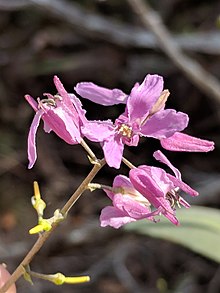Streptanthus bracteatus
| Streptanthus bracteatus | |
|---|---|

| |
| S. bracteatus in Travis County, Texas, US | |
| Scientific classification | |
| Kingdom: | Plantae |
| Clade: | Tracheophytes |
| Clade: | Angiosperms |
| Clade: | Eudicots |
| Clade: | Rosids |
| Order: | Brassicales |
| Family: | Brassicaceae |
| Genus: | Streptanthus |
| Species: | S. bracteatus
|
| Binomial name | |
| Streptanthus bracteatus | |

Streptanthus bracteatus is a species of flowering plant in the mustard family known by the common names bracted jewelflower[1] and bracted twistflower. It is endemic to Texas in the United States.[2][3]
This annual or biennial herb has a branching stem up to 1.2 meters tall. It is hairless and generally waxy in texture. The basal leaves have lobed or toothed blades on long petioles, and the leaves higher on the stem have smooth or toothed edges. The inflorescence is a raceme of flowers and bracts. Each flower has a bell-shaped calyx of sepals and four purple petals which may be nearly 2 centimeters long. The fruit is a long, flattened silique up to 14.5 centimeters in length.[4]
This plant is native to the Balcones Escarpment on the Edwards Plateau in Texas. It grows on clay soils in several habitat types.[2] It may be found in areas where it is protected from herbivory by a dense layer of shrubs.[3] The U.S. Fish and Wildlife Service has declared the bracted twistflower a threatened species.[5]
References
[edit]- ^ NRCS. "Streptanthus bracteatus". PLANTS Database. United States Department of Agriculture (USDA). Retrieved 4 December 2015.
- ^ a b Streptanthus bracteatus. Center for Plant Conservation.
- ^ a b Streptanthus bracteatus. The Nature Conservancy.
- ^ Streptanthus bracteatus. Flora of North America.
- ^ U.S. Fish & Wildlife Service: ECOS (Environmental Conservation Online System): Bracted twistflower (Streptanthus bracteatus). [1] Retrieved 11 April 2023.

